The most compelling book ever written on trading markets is Edwin Lefvre's classic,
Reminiscences of a Stock Operator
. First published in 1923, it's a thinly disguised biography of Jesse Livermore, a man regarded by many as the greatest stock trader of all time. It's packed with useful maxims for investors. Rereading it recently, I came across this one:
MoneyWeek
Subscribe to MoneyWeek today and get your first six magazine issues absolutely FREE

Sign up to Money Morning
Don't miss the latest investment and personal finances news, market analysis, plus money-saving tips with our free twice-daily newsletter
Don't miss the latest investment and personal finances news, market analysis, plus money-saving tips with our free twice-daily newsletter
"Nowhere does history indulge in repetitions so often or so uniformly as in Wall Street. When you read contemporary accounts of booms or panics, the only thing that strikes you most forcibly is how little either stock speculation or stock speculators differ from yesterday. The game does not change, and neither does human nature."
With that in mind, look at the table (below), compiled by Bob Hoye of Institutional Advisers. It outlines the important dates in the great stockmarket crashes of 1873, 1929 and 2008.
TABLE.ben-table TABLE {BORDER-BOTTOM: #2b1083 3px solid; BORDER-LEFT: #2b1083 3px solid; FONT: 0.92em/1.23em verdana, arial, sans-serif; BORDER-TOP: #2b1083 3px solid; BORDER-RIGHT: #2b1083 3px solid}TH {TEXT-ALIGN: center; BORDER-LEFT: #a6a6c9 1px solid; PADDING-BOTTOM: 10px; PADDING-LEFT: 5px; PADDING-RIGHT: 5px; BACKGROUND: #2b1083; COLOR: white; FONT-WEIGHT: bold; PADDING-TOP: 10px}TH.first {TEXT-ALIGN: left; BORDER-LEFT: 0px; PADDING-BOTTOM: 5px; PADDING-LEFT: 2px; PADDING-RIGHT: 2px; PADDING-TOP: 5px}TR {BACKGROUND: #fff}TR.alt {BACKGROUND: #f6f5f9}TD {TEXT-ALIGN: center; BORDER-LEFT: #a6a6c9 1px solid; PADDING-BOTTOM: 5px; PADDING-LEFT: 2px; PADDING-RIGHT: 2px; COLOR: #000; PADDING-TOP: 5px}TD.alt {BACKGROUND-COLOR: #f6f5f9}TD.bold {FONT-WEIGHT: bold}TD.first {TEXT-ALIGN: left; BORDER-LEFT: 0px}
| Start of crash | Early Sept | 3 Sept | 28 Aug |
| Heaviest liquidation | Late Oct | 29 Oct | 27 Oct |
| Low volume final panic | 8 Nov | 13 Nov | 20 Nov |
| Rebound top | May 1874 | 17/30 Apr | Jan 09 |
| Bear market low | Mid 1877 | Mid 1932 | 2011-12? |
Now, you could argue as I would that our low-volume final panic came on 6March 2009, and we are now enjoying a sustained bear market rally, which could go on for several weeks or months. But however you see it, there is no disputing the uncanny similarities.
All three booms followed periods of credit expansion, or loose lending, on an unprecedented scale, and the subsequent busts were caused by this excess credit suddenly contracting. The timescale of the unfolding of the busts is the same. Even the pronouncements of senior economists have been the same. We had John Maynard Keynes in 1927 saying: "We will not have any more crashes in our time." During the most recent boom, we had Federal Reserve chief Ben Bernanke's 2005 gem in The Washington Post: "There is no housing bubble to go bust." And just as night follows day, depression followed the busts of 1873 and 1929 as it will now.
Policy-makers will continue to declare imminent recovery. Last month, Bernanke said we will see it in 2010. Reassuring, perhaps, until you realise that in 1930, US Treasury Secretary Andrew Mellon declared: "There is nothing in the situation to be disturbed about", while the Harvard Economic Society repeatedly said "the severest phase of the recession is over" and "the outlook is favourable".
Then, just as now, governments and central bankers threw money at the problem. While today's authorities have slashed interest rates and moved on to quantitative easing (printing money), a Fed memorandum following the 1929 crash shows they made similar moves back then: "The drain upon bank reserves was met in the classic way with a policy of free lending." And, in fact, as far back as 1825, following similar problems, a report from the Bank of England then the global senior bank read: "We lent by every possible means and in modes we have never adopted before; we took in stock on security, we purchased Exchequer bills, we made advances on Exchequer bills, we not only discounted outright, but we made advances on Exchequer bills of exchange to an immense amount, in short, by every possible means seeing the dreadful state in which the public were, we rendered every assistance." The economy didn't recover until after 1840.
So how does this all affect us as investors? There is little we can do to change government policy. A great train we might call it the 'Queaser' has been set in motion by central bankers worldwide and nothing can stop it. It must either crash or run out of fuel. All we as individuals can do is make sure we are protected. But how?
Today's big bull market
Well, given the historical parallels with previous boom-busts of this magnitude, it is not unreasonable to expect the 'post-bubble contraction' to pan out similarly. So what does the past tell us about what to invest in now?
Cast your eyes over the first chart below. It shows the Dow (black line) versus the share price of Homestake (red line), the main gold miner of the period between 1924 and 1929. Notice how the Dow and Homestake moved up together in the four years leading to 1928. Then, as the Dow continued to rise, Homestake went flat in 1928-1929, before a brief spike up. Then they both sold off heavily in the crash of 1929. Homestake gave back all the gains of the previous three years and found support at the lows of three years earlier.
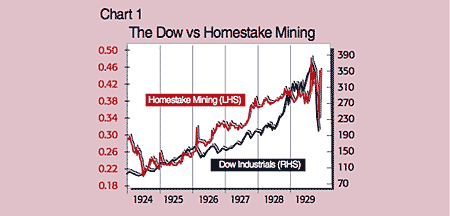
Chart two shows the HUI, the index of major, unhedged US gold miners. From 2003 it rose with the broader markets, then went flat in 2006-2007. It spiked up briefly in 2008, before crashing with the wider markets, giving back all its gains of the last few years. It then found support at 150, which happened to be the 2004 and 2005 lows. In other words, it has mapped out precisely the same pattern as Homestake in the 1920s. If this repeating pattern continues, gold shares will do very well in the coming years.
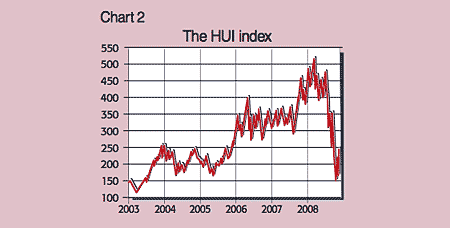
Why? Look at chart three the Dow versus Homestake after the 1929 crash. Although the Dow continued its declines in 1930 and 1931, Homestake decoupled from the broader trend. It stayed flat, then began an uptrend. By 1936 you were looking at a cool ten-bagger.
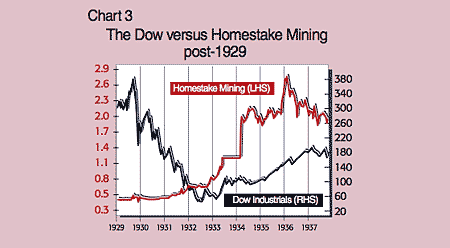
Now look at chart four, which shows the Dow versus the HUI since the October 2008 lows. The Dow made a lower low in November, then an even lower low in March. But gold stocks made their low in October. Since then they are up 90%. Just like Homestake in the 1930s, they have decoupled. This is the current pattern: they trade sideways or slightly down as the Dow declines, then move up exponentially with most Dow rallies. But, in my view, we ain't seen nothing yet. If history continues to repeat, and the HUI rises tenfold from its lows at 150, we will see it somewhere north of 1,500. Goodness knows where that will put some of the junior miners.
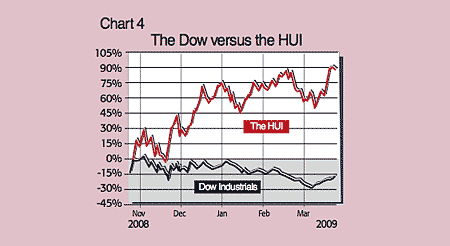
Possible objections
Some of you will point to the fact that President Franklin D. Roosevelt made it illegal for US citizens to own gold in 1933. He confiscated gold in exchange for dollars and then revalued gold upwards (or the dollar downwards) from $22 an ounce to $35. So it's little wonder that Homestake's share price spiked in 1934. First, the company's profits multiplied overnight. Second, while US citizens could not own gold, they could own gold shares and so the cleverer ones piled into Homestake. No such revaluation of gold could happen now, you might argue. I wouldn't be so sure.
The suggestion in early 2007 that more than 50% of British banks would be nationalised within two years was far more outlandish. Yet as 2008 demonstrated, just about anything is possible. You might argue that it was different then because America was on a gold standard, but it was only a nominal one. The Fed could still inflate credit.
We have shown already how history repeats. Aren't Obama's policies the same as Roosevelt's? The similarities between the two inaugural speeches were uncanny. Both men said the nation "calls for action". "Our distress comes from no failure of substance," said Roosevelt. Obama insisted that "our workers are no less productive than when this crisis began". Obama blamed the weakening of the economy on the "greed and irresponsibility of some", while Roosevelt condemned the "practices of the unscrupulous money changers". Obama, with his pledges of massive government spending, is following precisely the same route as Roosevelt.
Britain and the US have too much debt. As the crunch has unfolded, they have taken on even more. So how will we ever pay it back? Let's look at the options.
Ways to pay back the debt
One is to pay it back fairly and squarely. To raise the money we would need to put up taxes, cut government and welfare spending, shrink the public sector, stop bailing out banks and allow them to go bust, raise interest rates, allow unemployment to skyrocket and start producing stuff that foreigners want to buy. This would result in our economies becoming leaner and more efficient. Work off the last 20 years of consumption and we might be able to pay back our creditors within, say, ten or 20 years. What sane politician with a remote chance of winning an election would go to the people with a manifesto like that? I happen to think they'd be surprised by the favourable response they'd get. Nevertheless, the odds of this occurring are up there with finding Elvis, Shergar and Lord Lucan on the moon.
The other option is to default on our debt. There are two ways of doing this. We could simply refuse to pay it back, but I don't see this happening. Neither Britain nor America are full-blown banana republics not yet, anyway. So we're left with the sneakier option. We print a load of money and pay it back with currency that is worth a lot less. That is the path we are on. We have seen interest rates cut to zero. The Bank of England and the Fed have pledged to purchase US Treasuries and UK gilts. Central banks seem to be competing to devalue their currencies. It's a race to the bottom. What next?
When it comes to devaluing currency, revaluation of gold is a powerful tool in the box. People have suggested that gold will go to $2,000, $3,000 or even, as Marc Faber of the Gloom, Boom and Doom Report suggests, $5,000 an ounce in the open market. I am suggesting, however, that within four years we might get an official, government-stamped revaluation of gold.
There are several ways this could occur. Conspiracy theorists lurking in the darker corners of the internet will point out that confiscation of the metal is one way to revalue gold. In the 1930s the US Treasury sought to stop people hoarding or saving, call it what you will and start spending. Central bank policy is all about encouraging the same now. Policy-makers do not want to see their newly printed money spent on gold bullion and stuffed under the mattress. Money spent on hoarded gold will not revitalise the economy. In fact, a mass panic into gold would lead the economy in a vertical nosedive.
So a simple trade for US policy-makers would be to confiscate gold perhaps by confiscating the gold exchange-traded fund (ETF), GLD and paying off the ETF holders with newly printed money. The idea then would be to revalue gold upwards and repay the dollar-denominated debt with the newly revalued gold. But I don't think that will happen either. The theory is unrealistic.
Another possibility is that the central banks voluntarily go back to some kind of post-Bretton Woods gold standard in order to achieve some kind of stability. Both Russia and China have in recent weeks called for some kind of international currency. This week Russia called for it to be partly backed by gold. But the logistics of forming an international currency that is acceptable to all do not bear thinking about, unless it is 100% gold the only independent money. I don't think revaluation will occur this way.
However, while a move towards a global gold-backed currency looks unlikely, that doesn't mean it couldn't happen on a national level. Here's how I think it could happen. We've seen this sudden public anger with banks and bankers, fuelled partly by politicians using them as scapegoats. Fred Goodwin's house has even been vandalised. But eventually, as there is more and more financial and economic analysis on primetime TV and radio, people will realise that the problem isn't just banks or politicians, it's nationalised currencies. People will realise the only way to get some level of accountability into our government and financial system is to go back to some kind of a gold standard. First academics need to get it, then popular commentators, and then it will spread by osmosis through the public to politicians, who will adopt the policy in order to get elected. It will be a fudged gold standard, I'm sure gold won't become legal tender but gold will get revalued in the process.
The only way to make a return to any gold standard work without a horrendous deflationary bust would be a dramatic upwards revaluation of gold. It will have to be of a much greater scale than 1933 because of the scale of the underlying debt. We're not there yet, but it is coming. It will suit the Chinese. They're the world's biggest gold producer. It will suit the Americans. They have the world's largest gold reserves, even if they won't allow an independent audit of Fort Knox. It will suit the Germans, who have it in their vaults, and the Russians, who have it in the ground. But it won't suit us. We sold it. If you wonder where it's gone, ask Mr Brown.
Once national currencies return to some kind of gold standard, there will no longer be the need for an international currency. But however revaluation occurs, I remain convinced that the party of the next five years will be in gold stocks. You can read about my favourite shares below.
The best ways to buy into gold
Spring and summer are a bad time of year for gold and gold stocks, so don't rush into the sector if you don't already own some. In the short-term (between now and August), I'm neutral on gold. We have some range-trading to get through. Gradually accumulate over the summer if and when gold sells off. Don't chase gold up. It has a habit of beating you up if you do. The same goes for junior miners let the price come to you.
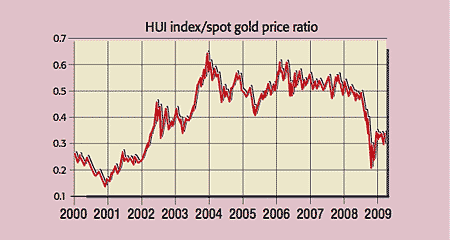
As the ratio of gold stocks to gold shows (see the chart above), gold stocks are a lot cheaper than bullion at the moment. In other words, miners offer better value, although of course they carry more risk. The easiest way to buy gold stocks is via an exchange-traded fund (ETF). Market Vectors GoldMiners ETF (NYSE:GDX) tracks Amex's gold miners, while ETFS Russell Global Gold Fund (LSE:AUCO) tracks the Russell Global Gold Index. Fund management groups Blackrock and Investec also both have gold funds. Another lower-risk option is to buy royalty firms, which purchase gold by-products from existing mines or mines under construction. Often gold will be a by-product of a copper mine, for example. Royalty firms are in many ways halfway between a mining company and bullion. They don't carry the risk of miners and aren't exposed to problems such as rising mining costs. The majors are Royal Gold (NASDAQ: RGLD) and Franco Nevada (TSE:FNV) and a new kid on the block, Gold Wheaton (CDNX:GLW), which I like a lot. For various reasons, this has lagged the others, but at under 25 Canadian cents, it's a buy.
As for individual junior miners, consider Gold Resource Corp (OTC:GORO), operating in southern Mexico, which should be making its first pour of gold this summer. Within three years, the miner aims to be producing 200,000 ounces a year at a cash cost of zero (by the time you offset its base metal production). So the company would survive a capitulation in the gold price, should it happen. With a gold price at $900, earnings should hit about $180m a third of which management, which has a large stake in the company, intends to pay to shareholders as a dividend. Another third will go on exploring and developing the group's other properties, which are already showing bonanza grades. The company's market capitalisation is about $160m. A dividend-paying stock with blue sky potential, it's every investor's dream. It's a buy at $4 or below.
European Goldfields (AIM: EGU) is developing various properties in Greece and Romania. It has no debt, although it will have to raise some money later this year. Management is solid, and its mines are economic, even at lower metals prices. The group has some cash flow now, but by 2011 four mines should be in production with, if all goes to plan, 500,000 ounces a year of gold and four million ounces of silver, as well as significant amounts of copper, lead and zinc. Buy below $3 or at £1.65.
A speculative but exciting play for the brave-hearted is Sacre Coeur Minerals (CDNX: SCM). This miner is uncovering a potentially huge gold trend on its Million Mountain project in Guyana. Zone one, just a few% of the targeted area, proved to have 450,000 ounces of gold, and more is inferred; drilling starts this month on zone two, which has surface gold anomalies 14 times larger. Does this mean there'll be 14 times as much resource? Locals think so. They call it the 'Billion' Mountain Zone. There is also the possibility of some near-term production potential to generate cash flow, and the management team's track record is excellent. This is a risky, small-cap play, but one that could easily pay off even if it fulfils just part of its potential.
Wits Gold (ZA:WGR/TSE:WGR) operates in one of the world's most prolific gold-producing regions, the Witswaterrand in South Africa. The miner has 150 million proven ounces in the ground. That gives it the fifth-largest resource in the world, athough some of it is extremely deep in the ground. The firm is valued at about 70c per gold ounce in the ground very cheap. It has low burn rates and enough cash to see it through the next three to five years. It is unlikely we'll see any production from Wits Gold alone it's more likely that as it finds more and more ounces it will enter a joint venture with one of its neighbours, Harmony, or Gold Fields. With the share price now back where it was when it listed, Wits Gold is a potentially very lucrative long-term option on gold. Did I mention the 54 million pounds of uranium.
Dominic Frisby writes regularly on commodities for Money Morning, MoneyWeek's free daily email. He also presents Commodity Watch Radio
Get the latest financial news, insights and expert analysis from our award-winning MoneyWeek team, to help you understand what really matters when it comes to your finances.
MoneyWeek is written by a team of experienced and award-winning journalists, plus expert columnists. As well as daily digital news and features, MoneyWeek also publishes a weekly magazine, covering investing and personal finance. From share tips, pensions, gold to practical investment tips - we provide a round-up to help you make money and keep it.
-
 Zoopla: house price growth stalled in 2025 but forecasts for 1.5% higher next year
Zoopla: house price growth stalled in 2025 but forecasts for 1.5% higher next yearSales soared this year with more than a million deals done but buyers drove hard bargains keeping a lid on prices. A small bounceback in valuations is predicted for 2026, depending on where you live.
-
 UK sets out crypto regulatory proposals
UK sets out crypto regulatory proposalsThe government has tabled legislation that sets out a regulatory framework for cryptocurrencies, while the regulator will consult on balancing innovation and consumer protections


